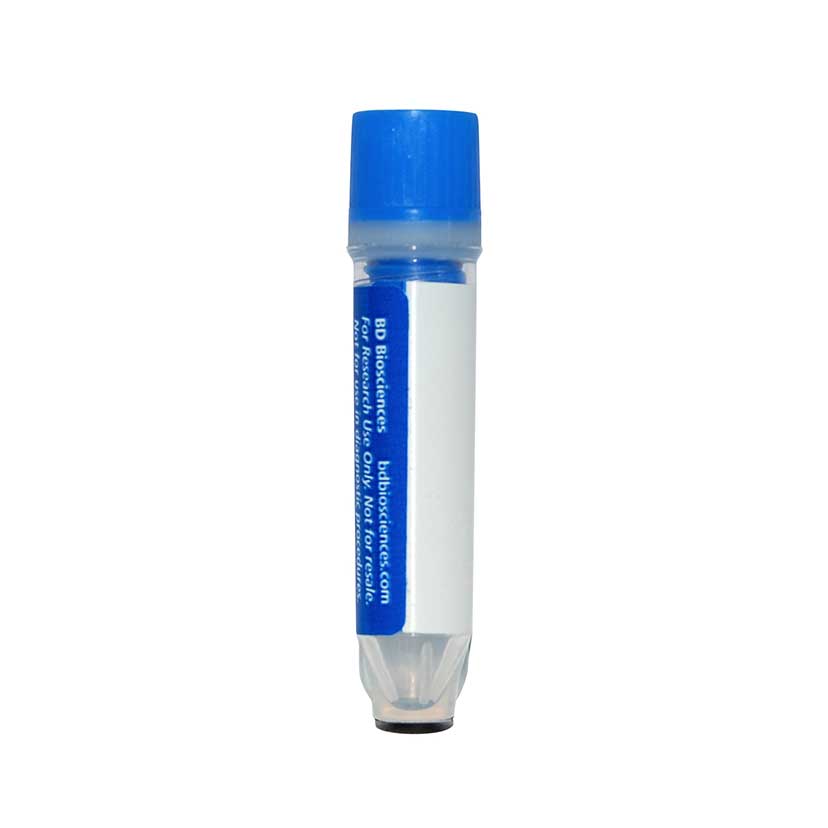-
Reagents
- Flow Cytometry Reagents
-
Western Blotting and Molecular Reagents
- Immunoassay Reagents
-
Single-Cell Multiomics Reagents
- BD® OMICS-Guard Sample Preservation Buffer
- BD® AbSeq Assay
- BD® Single-Cell Multiplexing Kit
- BD Rhapsody™ ATAC-Seq Assays
- BD Rhapsody™ Whole Transcriptome Analysis (WTA) Amplification Kit
- BD Rhapsody™ TCR/BCR Next Multiomic Assays
- BD Rhapsody™ Targeted mRNA Kits
- BD Rhapsody™ Accessory Kits
- BD® OMICS-One Protein Panels
- BD OMICS-One™ WTA Next Assay
-
Functional Assays
-
Microscopy and Imaging Reagents
-
Cell Preparation and Separation Reagents
Old Browser
This page has been recently translated and is available in French now.
Looks like you're visiting us from {countryName}.
Would you like to stay on the current location site or be switched to your location?
BD™ AbSeq Oligo Mouse Anti-Human CD119
Clone GIR-208 (RUO)


Regulatory Status Legend
Any use of products other than the permitted use without the express written authorization of Becton, Dickinson and Company is strictly prohibited.
Preparation And Storage
Recommended Assay Procedures
Put all BD® AbSeq Reagents to be pooled into a Latch Rack for 500 µL Tubes (Thermo Fisher Scientific Cat. No. 4900). Arrange the tubes so that they can be easily uncapped and re-capped with an 8-Channel Screw Cap Tube Capper (Thermo Fisher Scientific Cat. No. 4105MAT) and the reagents aliquoted with a multi-channel pipette.
BD® AbSeq tubes should be centrifuged for ≥ 30 seconds at 400 × g to ensure removal of any content in the cap/tube threads prior to the first opening.
Product Notices
- This reagent has been pre-diluted for use at the recommended volume per test. Typical use is 2 µl for 1 × 10^6 cells in a 200-µl staining reaction.
- Source of all serum proteins is from USDA inspected abattoirs located in the United States.
- Caution: Sodium azide yields highly toxic hydrazoic acid under acidic conditions. Dilute azide compounds in running water before discarding to avoid accumulation of potentially explosive deposits in plumbing.
- The production process underwent stringent testing and validation to assure that it generates a high-quality conjugate with consistent performance and specific binding activity. However, verification testing has not been performed on all conjugate lots.
- Illumina is a trademark of Illumina, Inc.
- Please refer to http://regdocs.bd.com to access safety data sheets (SDS).
- Please refer to bd.com/genomics-resources for technical protocols.
- For U.S. patents that may apply, see bd.com/patents.
Companion Products






The GIR-208 antibody recognizes the extracellular region of CD119 which is also known as the alpha chain subunit (80-95 kDa glycoprotein) of the human interferon-γ receptor (IFN-γRα). The functionally active-form of the human IFN-γ receptor consists of two (or more) subunits, with IFN-γRα responsible for IFN-γ binding and both the IFN-γRα and β chains required for the transduction of biologic responses. The IFN-γ receptor α chain (CD119) is expressed on the surface of most human cells (except mature erythrocytes) including monocytes, macrophages, T cells, B cells, NK cells, neutrophils, fibroblasts, epithelial cells, and endothelium. Binding of 125I-labeled GIR-208 antibody to IFN-γRα+ cells is reported to be specifically inhibited in the presence of excess IFN-γ. GIR-208 does not cross react with IFN-γ as tested by ELISA. The ability of this antibody to bind to IFN-γ receptors of species other than human has not been determined. The immunogen used to generate this hybridoma was human IFN-γRα purified from human placenta. The GIR- 208 has been reported to block the binding of 125I-human IFN-γ to IFN-γRα+ cells as well as purified, soluble human IFN-γRα. GIR-208 is a neutralizing antibody that has been shown to neutralize the anti-viral activity of IFN-γ on WISH cells in a dose-dependent fashion.
Development References (6)
-
Bach EA, Aguet M, Schreiber RD. The IFN gamma receptor: a paradigm for cytokine receptor signaling. Annu Rev Immunol. 1997; 15:563-591. (Biology). View Reference
-
Gumina RJ, Freire-Moar J, DeYoung L, Webb DR, Devens BH. Transduction of the IFN-gamma signal for HLA-DR expression in the promonocytic line THP-1 involves a late-acting PKC activity. Cell Immunol. 1991; 138(2):265-279. (Clone-specific: Neutralization). View Reference
-
Kishimoto T. Tadamitsu Kishimoto .. et al., ed. Leucocyte typing VI : white cell differentiation antigens : proceedings of the sixth international workshop and conference held in Kobe, Japan, 10-14 November 1996. New York: Garland Pub.; 1997:818-821.
-
Peyman JA, Hammond GL. Localization of IFN-gamma receptor in first trimester placenta to trophoblasts but lack of stimulation of HLA-DRA, -DRB, or invariant chain mRNA expression by IFN-gamma. J Immunol. 1992; 149(8):2675-2680. (Biology). View Reference
-
Sheehan KC, Calderon J, Schreiber RD. Generation and characterization of monoclonal antibodies specific for the human IFN-gamma receptor. J Immunol. 1988; 140(12):4231-4237. (Immunogen: Neutralization, Western blot). View Reference
-
Valente G, Ozmen L, Novelli F. Distribution of interferon-gamma receptor in human tissues. Eur J Immunol. 1992; 22(9):2403-2412. (Biology). View Reference
Please refer to Support Documents for Quality Certificates
Global - Refer to manufacturer's instructions for use and related User Manuals and Technical data sheets before using this products as described
Comparisons, where applicable, are made against older BD Technology, manual methods or are general performance claims. Comparisons are not made against non-BD technologies, unless otherwise noted.
For Research Use Only. Not for use in diagnostic or therapeutic procedures.